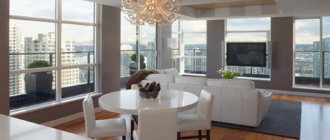07.02.2016 8 095
Often, buyers have only a superficial idea of
how to choose an apartment and by what criteria to determine its value .
With this approach, buying an apartment can become a bad investment. Living in it is unlikely to bring joy, and the inability to resell it will only increase the bitterness of disappointment. The real estate market never ceases to be replenished with new offers. Among this diversity, you can easily get lost and, worst of all, make a mistake. Therefore, before you start looking for an apartment, you need to set yourself clear guidelines by which the selection will take place: starting from determining the purpose of the purchase, the budget, and ending with which floor to choose when buying an apartment. Ultimately, it is necessary to draw up a complete list of specific requirements for the desired housing.
Pros and cons of apartments located on the ground floor
Many people prefer to buy property on the ground floor.
Pros:
- Housing prices have been reduced, which helps you save money.
- A family with disabled people or small children will be able to go outside with ease.
- Very often, apartments on the first floors are bought for retirees (especially if children live far away).
- In the event of a fire, residents of the first floors will be able to evacuate freely.
Minuses:
- Due to the close location to the basements, the humidity in the apartment is constantly increased.
- The lighting is worse due to the trees.
- It is necessary to constantly curtain the windows and make bars.
- In winter, cold creeps into the apartment due to its close proximity to the entrance door.
- All floors except the first have balconies, which is not very convenient, because residents need somewhere to dry their clothes.
Which floor is more profitable and convenient?
The first and last floors are traditionally cheaper.
- But residents of the first floors often complain that they live “literally on the street” - it’s noisy, there’s a constant feeling that anyone can peek in.
- On the top floors, if the quality of the building is not high, the ceilings may leak during periods of increased precipitation. And a broken elevator will be a serious problem.
Floors from the second to the seventh or eighth are considered optimal.
Tall enough to prevent passers-by from looking out the window. Close enough in case the elevator breaks down.
The specific choice is purely a matter of taste. Some people prefer to look at the “treetops”, while others prefer to go down just one flight of stairs.
Pros and cons of the last floor
Pros:
- There are no neighbors upstairs, so noise and trampling will not disturb you. When you go out onto the balcony, you won’t see a cigarette butt flying overhead or debris from knocked-out rugs.
- Good lighting.
- There is no need to curtain the windows, as no one will be watching you.
- You can make a fireplace with a chimney outlet to the roof (optional).
Minuses:
- If the elevator does not work, residents of the upper floors will have a hard time getting home, especially if they have small children or people with disabilities.
- If you purchase furniture, delivery is paid.
- Washing windows becomes an inconvenient procedure.
- It is difficult to rent out an apartment, since many people do not want to take it due to its shortcomings.
What's in the apartment - inspection of future housing
This section applies primarily to apartments on the secondary market. First, take care of your own safety - under no circumstances take a large amount of money with you, especially if the seller asks you to take a deposit with you. You risk waking up far outside the city without money or memory. For the same reason, ask a relative or friend to go with you - firstly, it’s safer, and secondly, together you can notice much more during the inspection. And don’t rush, running from one apartment to another; get acquainted with a maximum of two options a day.
Before choosing an apartment, get acquainted with the layout in general terms and check the technical data sheet. If you discover illegal redevelopment, it is better to stop the inspection there. If everything is fine, don’t hesitate to look into every crevice, take your time and think for a long time - you’re not going to buy a pair of shoes. Check every corner. Start with the front door - how secure is it?
Next, carefully inspect the bathroom, evaluate the quality of the pipes, plumbing, even the water pressure in the taps - open as many taps as possible. If the water distribution in the house is lower, then the upper floors will always experience problems with pressure. 90% of secondary apartments are infected with fungus - it feels especially good in bathrooms. It is even more dangerous in living rooms - under wallpaper and furniture. Only a major overhaul will help remove it, and if this is not planned, then you risk ruining your furniture and carpets.
The quality of parquet or laminate is also worth assessing. If the parquet creaks and wobbles, this indicates either a recent flood or constant changes in temperature and humidity. If the floor is tiled and when pressure is applied it moves and cracks, then the problem should be looked for in a bad screed. In these cases, mold can also live under the tiles and under the parquet.
During the cold season, feel the batteries and try to feel if there is any blowing coming from the corners. If you intend to move in immediately and live without renovation, then evaluate the condition of the floors, ceilings, and wallpaper. Analyze the tightness of windows and balcony glazing. Only after this begin negotiations with the owners.
New buildings
The trend of increasing prices every year applies specifically to apartments in new buildings. If you decide to purchase real estate in a new building with a mortgage, then banks will provide loans without any problems. You can get a loan to buy a secondary home, but the loan terms are less favorable.
This is the most risky option, since construction companies practice selling apartments either in an unfinished building or even when construction is at the stage of the zero cycle.
Before concluding a purchase and sale agreement for an apartment, find out:
- is there cadastral registration of the land plot on which the building is being erected, and what status does the land plot have?
- legal address of the construction company and coordinates of its director;
- how many subcontracting organizations are carrying out construction, their addresses and managers.
- require a permit to carry out construction work;
- if a company sells apartments at dumping prices, then it is better not to take risks and not enter into a deal.
A big disadvantage when buying an apartment in a building under construction is the chronic delay in putting the house under construction into operation. There has even been a community of defrauded real estate investors who are fighting for their rights to obtain legally purchased housing.
The buyer should be wary of the seller’s proposal, which offers to pay for the living space as a contribution to the shared construction of a house. This may be a signal that the construction company is experiencing financial difficulties and is trying to save its position at the expense of potential apartment buyers.
New building or resale
Despite vigorous debate, there is no clear solution. To choose the right one, you should consider the pros and cons of both options.
New building
- purchase with a preferential mortgage at 6.5%
- lower price
- modern planning standards
- no previous owners
- entrances with a high level of security
- in 75% of cases a full repair is required
- will have to wait for construction to be completed
- At first, the neighbors will also have renovations
- rising in price rapidly
Secondary
- in good condition does not require repair
- interior renovation is inexpensive and quick
- utility bills are often cheaper than in new buildings
- as a rule, all infrastructure is available
- no need to wait for construction to be completed
- may cost more
- increases in price more slowly
- if the housing is in poor condition, you will have to make expensive major repairs
- the old entrance may be in questionable condition
Depending on the object, the pros and cons may vary:
- Some new buildings, due to their location, are more expensive than resale buildings
- the developer can sell part of the apartments with finishing
- housing in an old house may require more expensive repairs than finishing in a new building
- if a metro is being completed next to the secondary building, or an important infrastructure complex is being built, the price will soon skyrocket
Advantages of apartments in new buildings
- All apartments are built according to an improved layout that meets all the amenities necessary for residents.
- Construction is carried out using new technologies using modern materials that meet construction standards and standards.
- All utility lines are connected to the house, which are distributed among the apartments in accordance with the communications plan
- Multi-storey buildings have two elevators: a passenger elevator and a freight elevator.
Before buying an apartment in a new building, evaluate the infrastructure of the area:
- availability of shopping and entertainment centers;
- proximity to public transport stops;
- availability of medical institutions, kindergartens and schools;
- well-kept house and the presence of playgrounds and parking spaces for cars.
Location
When buying real estate, you need to evaluate not only its internal condition, but also what is located outside. It is worth paying attention to the location of the housing: in what area it is located, how far from the house are educational institutions, shops, and the place of work of the future owner.
Those who have a car should choose a house where there is a parking lot nearby with free spaces. If future homeowners often use public transport, an apartment should be purchased close to bus stops.
There should be grocery and household stores nearby. If there are children in the family, you need to take a closer look at the availability of children's playgrounds and public gardens. When family members lead a healthy lifestyle and play sports, it is better to have a stadium or gym nearby. You also need to remember about healthcare institutions.
Secondary housing
The bulk of available housing on the real estate market is represented by secondary housing.
When choosing a secondary home, you need to find out:
- Are there any encumbrances on the apartment you have chosen? The arrest or apartment is pledged against a loan from the bank.
- Check with the housing and communal services office to see if all the residents previously registered in this apartment have checked out.
- After the privatization of the apartment, was there a share allocated for a minor child as part of the property?
- The seller of the apartment must provide a document confirming his legal capacity at the time of the transaction.
How to choose a secondary one
- Check for possible legal hassles
Straining factors should be registered incompetent persons (they cannot be forcibly discharged), the period of ownership of the property is less than 3 years (perhaps something is wrong with the property), ownership through a deed of gift (a generous granny may later change her mind and declare that she donated apartments under pressure or unconscious, and you will have to defend your rights in court.
You should also check the encumbrances of the apartment. Working with a reliable real estate agency generally reduces risks. But it is better to make sure for yourself that there are no debts on the property, it is not pledged, etc.
- Assess the condition of the wiring and pipes
A beautiful renovation can hide the deplorable state of communications. And replacing wiring, updating water supply, sewerage and heating can be much more expensive than any finishing.
- Talk to your neighbors
Find out whether there are accidents with power outages, what is the quality of the water (I have come across houses in which the water was either normal or completely rusty, and the management company did nothing).
- Explore the surrounding infrastructure
The secondary building, as a rule, is surrounded by everything necessary. The disadvantages may lie in the long-term habitability of the area. For example, a 24-hour store “under the windows” in the summer is 90% likely to become a source of noise. For some this will not be a big deal, but for others it will drive them crazy.
Make sure the infrastructure meets your needs and expectations.
- Check transport accessibility
“5 minutes from the metro” suddenly turns into 10 – 15 – 20, and by car. Fortunately, now it’s easy to check using Yandex or Google maps. But you definitely need to check it with your own “feet.” Map updates are sometimes delayed, and you can find some large-scale construction site on the way that you can’t get around or go around.
List of important factors
- Legal purity
- Location in a prosperous area
- Transport accessibility
- Status of basic communications
- Neighbours
- Infrastructure
- Finishing and interior
- Price
A simple way to compare and choose the right apartment, even without experience, is to rate each criterion on a 10-point scale. Such a mathematical calculation will quickly reveal the “winner”.
There is an option to purchase housing with a mortgage. What should you pay attention to?
If you are buying an apartment with a mortgage, the choice of housing will depend entirely on your financial capabilities.
Purchasing home ownership through a mortgage is carried out by agreeing on all documents with the bank that will issue the mortgage loan. This amount usually does not exceed the down payment on the mortgage. The bank takes the apartment as collateral.
There are a number of requirements for apartments taken on a mortgage:
- The living space must be located within the city.
- A document is required confirming that the house is not included in the list of emergency houses subject to demolition.
- Mortgages are issued only for apartments purchased in panel or brick houses. Banks do not take apartments in wooden houses as collateral, and therefore do not issue loans.
- Banks may impose requirements for the number of floors of a building.
When buying an apartment, you need to be careful and carefully check the documents provided by the seller for their authenticity. If you have the slightest doubt about the integrity of the seller and the authenticity of his documents, refuse the transaction without regret.
Your rating of the article
Advantages and disadvantages of new buildings - what to look for?
The popularity of apartments in new buildings is due to modern, comfortable layouts, larger apartment areas, as well as the use of modern building materials and technologies. By default, in such a house you can forget for a long time about problems with water supply or sewerage, a non-working elevator, smelly entrances and broken light bulbs.
By the way, it would be useful to carefully familiarize yourself with the technologies and materials. Perhaps the tempting price per square meter is due to the fact that the house is a prefabricated structure made of reinforced concrete blocks, and the builders inadvertently forgot about such important things as sound insulation, insulation, and waterproofing. But it is these technologies that will allow residents to save on rising utility rates in the future and feel as comfortable as possible.
In the case of new buildings, carefully examine the area - most new projects are being implemented quite far from the city center, and the developer does not always solve issues of transport and social infrastructure. Of course, until you have a small child, the presence of a kindergarten, school and hospital will not be so noticeable, but you will immediately notice the lack of parking.
It’s good if the house you have chosen for acquaintance is the second stage of a residential complex under construction - in this case, you have a great opportunity to communicate with people who have moved into the apartments of the first stage. Don’t be shy to ask questions; old grandmothers especially love to talk - they’ll tell you how to choose the right apartment, and at the same time tell you all the developer’s secrets.
Maybe they will enlighten you on the historical past of this area, and you will find out that the house was built on the site of a former cemetery or psychiatric hospital. You may be even more surprised by the results of geodetic research - it is important to be sure that the huge house does not stand above an underground lake, or its foundation is not undermined by groundwater.






